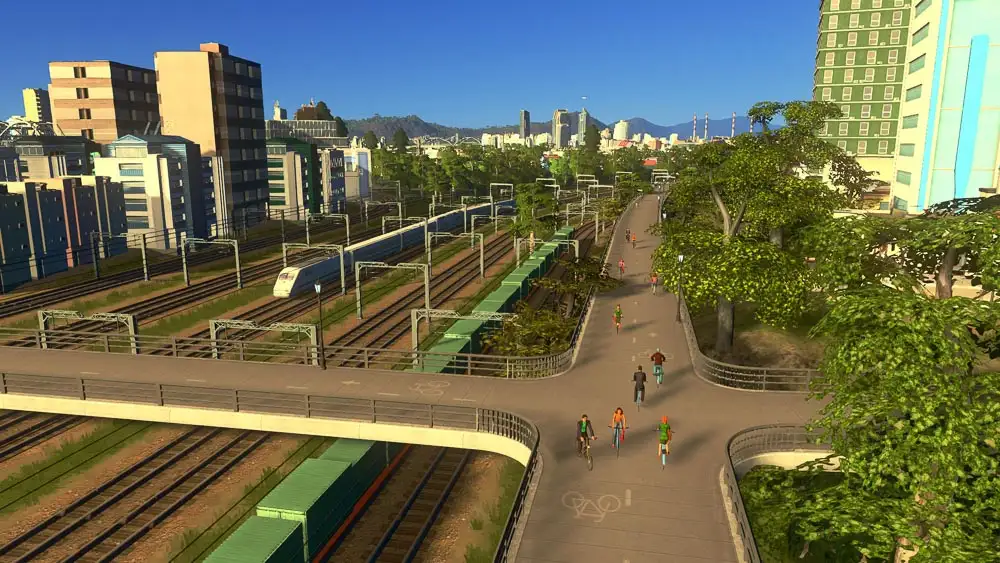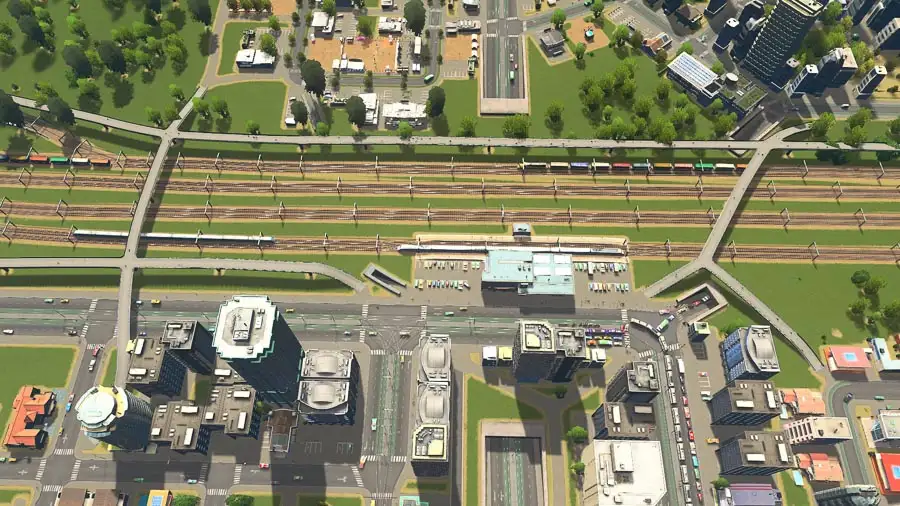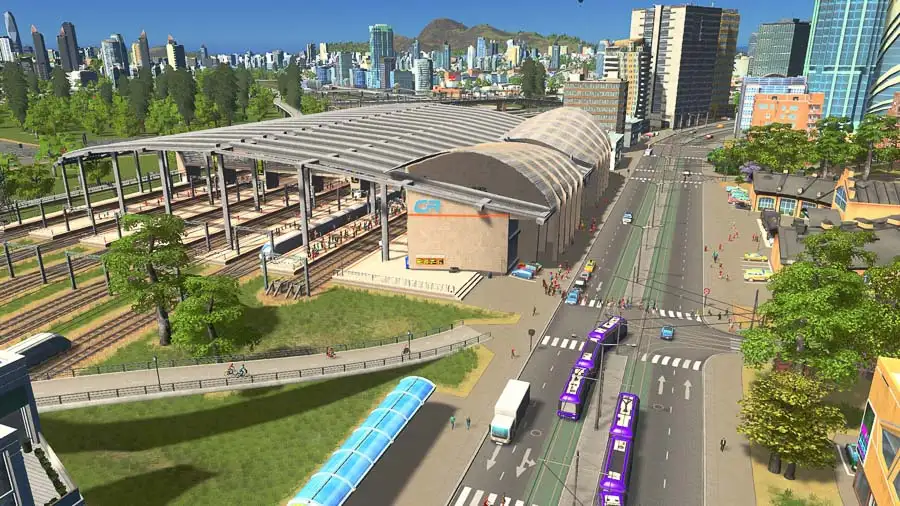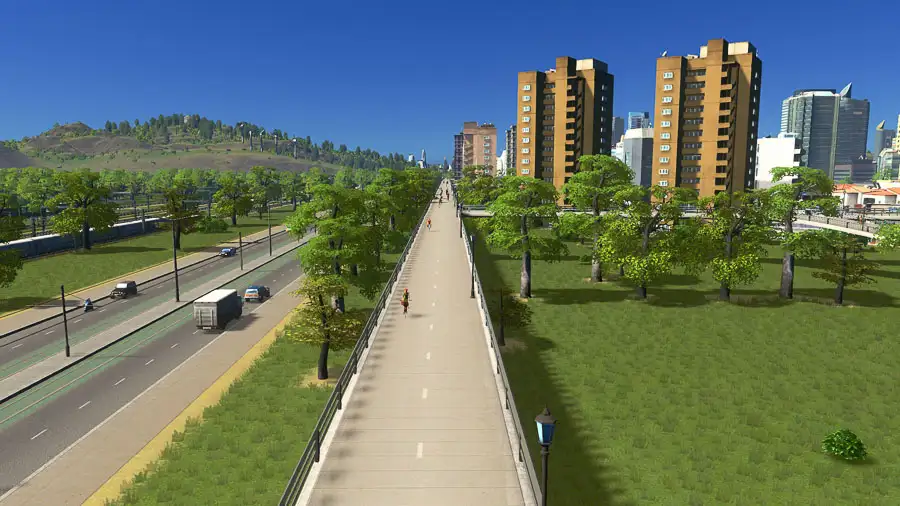
Biking arrived to Cities: Skylines in After Dark, the game’s first expansion. Suddenly, residents would hop onto a bike and ride the pavements and newly-added bike lanes. The pedestrian path got a bike-only counterpart, too - from which we can build huge networks of fast, direct cycle highways.
Bikes add visual life to the city and a good cycle network can also drastically reduce car traffic. In a neighbourhood designed from the outset for low car use, it’s possible to see almost no one driving at all. And that’s true even without a local bus network!
In real life, I don’t particularly enjoy riding on the road, but I love mountain biking and a good cycle path through a city makes me very happy. That’s why I like making bike highways that are separate from the road network. It’s a bonus if they pass through trees.
Compatibility
I’m talking about the vanilla, unmodded game here, with the first six expansions installed although After Dark is the only requirement. With AD installed, everything here applies across PC, Mac, Linux, Xbox, PS4 and Switch.
Bike behaviour and mechanics
In my quick overview of all public transport, I put biking in the medium distance travel category. That puts it ahead of buses and trams and alongside the metro and monorail. At first glance, that seems a bit odd, but I think it stands up. Once cims get going, bikes go surprisingly fast. Bike paths are also unconstrained by passenger throughput limits, meaning you’ll never have hundreds of people waiting at stops, and not enough vehicles to collect them.
Even without any optimisation, cims will happily ride on the sidewalk, bikes lanes, footpaths or bike paths.
Bike riding doesn’t seem to have any direct benefits for the population like increased health or happiness, which is a shame. That said, less noise from fewer engines does indirectly improve health. Compared to roads with trees, roads with bike lanes give less land value and create more noise.
Building fast, direct bike highways

The most efficient bike highways are direct and have few interruptions, which is where dedicated bike paths come in. Although a similar thing can be achieved with bike lanes, using separate bike paths with bridges and underpasses means bikers who are passing through don’t need to ride across road intersections. Keeping it separate makes cycle journeys faster, but it also avoids slowing down all of your road traffic. In busy areas of the city that’s potentially very important.
In practice, of course, it’ll be a mix of bike lanes, bike paths and basic pavements as you make compromises. Adding a crosswalk on a quieter side street means you can let cyclists cross away from main junctions. I’ve explained how to do that here.
As with public transport, bike highways should connect the places that people travel between: home and work, and home and leisure. By putting the highway close to big residential areas and close to the commercial centre, for example, lots of people will ride because it’s now the fastest route. Also, be sure to integrate routes fully with all the city’s major transit hubs.
For the main sections of your bike highways, long uninterrupted segments of bike path work best, with on and off ‘ramps’ at regular intervals as it passes through the city to give as many people as possible an easy way to get onto it.
I really like raised highways because of how they look, but running along the ground or even underground works just as well. It’s a bit dystopian, but a largely underground bike network would be great as long as you don’t need the space for metro tunnels or whatever.
Given how effective they are, I was always surprised at how the game doesn’t do much to push you in their direction. Active travel is the unsung hero of high traffic flow cities.
Residents seem to prefer paths and travel further than on roads

I can’t find the research now, but a couple of years ago someone posted a few tests on the Steam forums that seemed to show cims will prefer to take a footpath, even if it’s a little longer than the equivalent sidewalk/pavement.
Now I don’t know for sure, but it makes sense if the same also applies to bike paths. In other words, by adding specific bike paths you can extend the range that cims will travel compared to bike lanes.
If it exists, that functionality has a few benefits. You can place transport stops further apart, of course. It’ll also get people using the bike highways even when the road looks marginally shorter - making building them worthwhile.
Perhaps the biggest benefit is that by riding on the cycle paths, bikers aren’t having to cross junctions. In low traffic areas that’s not much of an issue, but in the city centre, large numbers of cyclists (and pedestrians) can bring important junctions to a standstill.
Biking city policies
Obviously, you wouldn’t want to enable the policy that bans cyclists from the pavements. If you do, cims might inadvertently be forced off their bikes and have to walk, significantly extending journey time. That could ruin the whole thing by making them choose to drive.
The Encourage Biking policy also arrived in After Dark. I can’t find anything in the game or published by Colossal Order that describes any downsides to the policy. My guess is the only negative is fewer people drive - but few people also take public transport, reducing your income.
Bike paths versus pedestrian paths
Visually, bike paths can be identified by their painted lanes and bike symbols but functionally, they’re very similar to pedestrian paths. Pedestrians can’t use bike paths, but cyclists can use pedestrian paths.
Which does beg the question: why use bike paths at all when pedestrian paths are clearly more flexible? Bike paths are not obviously faster, nor do cyclists seem to get held up by pedestrians, so on the face of it, using pedestrian paths seems the more versatile option.
I’ve not been able to find anything on it published by Colossal Order, or solid research showing it one way or the other. Regardless, I tend to use bike paths for my cycle highways because it looks better.
Occasional transition problems
Sometimes, I have noticed pathing behaviour I couldn’t quite understand. This post on the forums is an example. In this case, there’s a problem with how the bike paths connect with the roads.
I think that what might be happening here is that riders haven’t got a way of transitioning from the bike path to the bike lane, because they aren’t allowed to cross the sidewalk. I think that’s because there’s no valid junction for them to use - so keep that in mind when designing interchanges.
Roundup

I hope you found this handy! Biking is a great addition to the game and can genuinely replace a lot of local and even shorter medium-distance public transport routes. It’s especially good for connecting different city areas with fast, direct routes that have no problem with capacity and passenger throughput. Whether they’re over, under, or along the ground, bike highways can keep vast numbers of cars off the road, look great, and let you create your own Dutch-style biking haven.
Thanks for reading. If you end up buying After Dark and want to support the thanks (thanks so much!), please use one of these affiliate links: Humble Bundle. Thanks again!